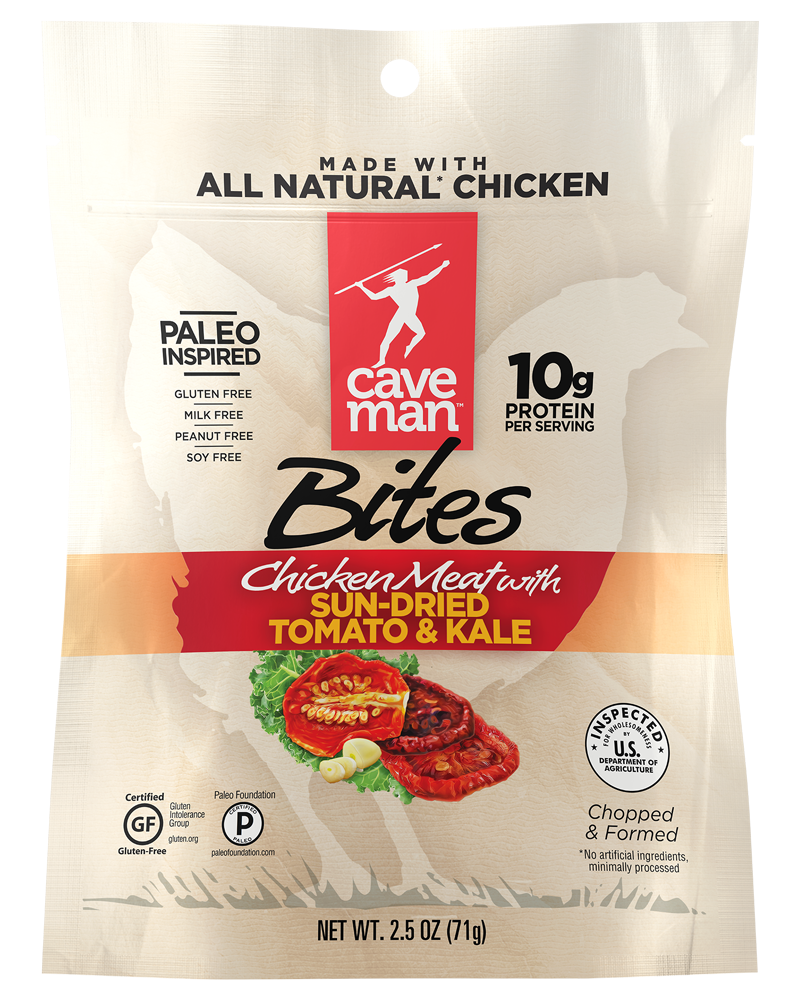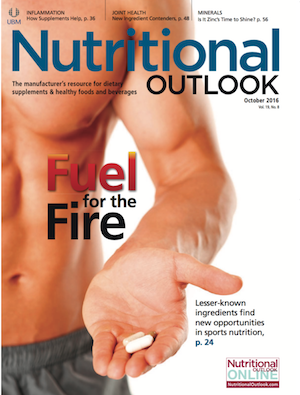Healthy Snack Trends: Paleo, Gluten-Free, and More
Top trends like paleo and gluten-free continue driving the healthy-snacks market.
Paleo snack brand Caveman Foods’ new Caveman Chicken Bites usher in what the company calls the “evolution” of traditional jerky. Produced in tender, bite-sized pieces that are easier to eat than traditional jerky, the Bites “are a great source of on-the-go protein, delivering 10 g of lean protein and only 70 calories per serving,” the firm says, adding that they are lower in sodium and sugar than traditional beef jerky as well. Sold in three flavors, the products feature all-natural chicken and other paleo-inspired ingredients and are certified by the Paleo Foundation.

The first word that comes to mind when snacking on impulse may not be healthy, but that hasn’t stopped snack makers from providing better-for-you options just the same. The snacks market as defined by Innova Market Insights encompasses a wide range of categories, including traditional savory or salty snacks, snack nuts, and seeds, as well as meat snacks, popcorn, fruit-based snacks, finger foods, and hors d’oeuvres.
Healthy Claims
More than 43% of global snack launches and 70% of U.S. snack launches Innova Market Insights recorded between May 2015 and May 2016 featured a health claim of some kind. These claims varied from “passive”-low-calorie, whole-grain, natural, etc.-to “active or functional,” such as vitamin and mineral fortified, added fiber, as well as claims of specific health benefits, such as for heart health or energy/alertness.
Of all passive health claims, clean-label and “free from” product claims were used most, particularly in the United States where prevalence is highest. “Natural,” “no additives/preservatives,” and/or organic claims featured on 28% of global launches and up to 48% of launches in the United States.
In the neighborhood of “free from” claims, non-GMO claims were especially popular in the United States. While nearly 7.7% of global snack launches featured a non-GMO claim, well over a quarter of those in the U.S. featured a non-GMO claim, up from merely 17% of launches two years prior.
Paleo Promise
Interest in natural products and a back-to-basics approach has led to more activity in paleo products (products associated with the so-called Paleo Diet and its focus on eating lean meat, nuts, fruits, and vegetables, as our Stone Age ancestors did).
Although paleo snacks only account for a still-modest 13% of snack introductions, use of the word paleo in launch activity has surged in recent years, with snacks as one of its top three product categories. More recently, the paleo sector has begun branching out beyond nuts and fruit mixes, as well as seed mixes, to encompass savory/salty snacks such as vegetable chips and grain-based crackers, as well as meat snacks.

Paleo snack brand Caveman Foods’ new Caveman Chicken Bites usher in what the company calls the “evolution” of traditional jerky. Produced in tender, bite-sized pieces that are easier to eat than traditional jerky, the Bites “are a great source of on-the-go protein, delivering 10 g of lean protein and only 70 calories per serving,” the firm says, adding that they are lower in sodium and sugar than traditional beef jerky as well. Sold in three flavors, the products feature all-natural chicken and other paleo-inspired ingredients and are certified by the Paleo Foundation.
Gluten-Free
Gluten-free claims are still going strong. During May 2015–May 2016, gluten-free claims were used in nearly 17% of global snack launches and in over 44% of U.S. launches. The gluten-free trend may be easier for snack makers to address simply because many basic snack ingredients-potatoes, corn, soy, and nuts-are naturally gluten-free.
Still, manufacturers are taking advantage of a wide range of other ingredients that can also replace wheat and other cereals, including lentils, beans, cassava, rice, nuts, and sweet potatoes, plus other traditional and on-trend vegetables like beetroot, kale, and sea vegetables.
High Protein
The snacks market is not immune to the high-protein trend overtaking the general food and drinks sector particularly in the United States. Just under 15% of total U.S. snack foods launches Innova Market Insights tracked in May 2015–May 2016 used “added protein,” “high in protein,” or “source of protein” claims. Sub-categories like meat snacks inherently benefit from high-protein claims and have taken the opportunity to leverage these claims more widely; for instance, more than 50% of U.S. meat-snack launches featured a protein claim.
Bars
Another type of snack with strong growth due to its healthy positioning is the cereal or granola bar. Despite concerns over how healthy some of these bars actually are, manufacturers are nonetheless emphasizing their healthier attributes. Over 80% of global cereal bar launches and up to 94% of U.S. cereal bar launches Innova Market Insights tracked in May 2015–May 2016 embraced healthy marketing. Clean-label concerns are big in granola bars, with nearly 53% of U.S. cereal bar launches positioned on a natural, additive-/preservative-free, and/or organic platform.
In the U.S. bar market, gluten-free claims were used on over 63% of bar launches-even more frequently than natural, additive-/preservative-free, and organic claims. Nearly 47% of U.S. bar introductions featured protein claims. And approximately one-fifth of U.S. performance-bar launches featured a sports/recovery or energy/alertness positioning.
Healthy and Delicious
All of this healthfulness aside, consumers still seek indulgence and good flavors. These consumers are clamoring for great-tasting, easily accessible products and new and improved snack formats optimizing taste, novelty, portability, and convenience. As the snacks market grows increasingly diverse and competitive, brands must evolve and cater to these shifting consumer preferences.
Innova Market Insights is your source for new-product data. The Innova Database (www.innovadatabase.com) is the product of choice for the whole product-development team, offering excellent product pictures, search possibilities, and analysis. See what food manufacturers are doing around the world: track trends, competitors, ingredients, and flavors. In today’s fast-moving environment, this is a resource you cannot afford to be without.
Also read:
Latest Sports-Nutrition Product Trends
Soft Drinks: Healthier, Natural, Clean Label

Prinova acquires Aplinova to further increase its footprint in Latin America
April 7th 2025Prinova has recently announced the acquisition of Brazilian ingredients distributor Aplinova, which is a provider of specialty ingredients for a range of market segments that include food, beverage, supplements, and personal care.

























